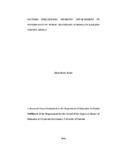| dc.description.abstract | The purpose of the study was to establish factors influencing students‟ involvement in governance in public secondary schools in Kajiado County. The study was guided by the following objectives: examine the influence of principal‟s gender on students‟ involvement in governance, establish the influence of school size on students‟ involvement in governance, to determine the influence of school type on students‟ involvement in governance, and to identify the different modes in which students are involved in governance in public secondary schools in Kajiado County. The study employed a descriptive survey design targeting a population of 40 principals, 480 teachers and 1080 students. Participating schools were first categorized into county and district schools and then stratified according to type – boys‟ only, girls‟ only, mixed day and boarding and mixed day schools. Out of the targeted1080 students, 115 were sampled. In addition, 24 principals and 169 teachers were also sampled to participate. Questionnaires designed for principals, teachers and another one for students were used for data collection. Instrument reliability was established at 0.74. Data was both qualitative and quantitative. Quantitative data collected was coded and entered into an SPSS programme for analysis using tables, frequencies, percentages, bar graphs and pie-charts. Qualitative data was put under themes consistent with the research objectives. The issues requiring open-ended questions were analyzed qualitatively. Data was then analyzed both manually and by use of Statistical Package for Social Sciences (SPSS). The study established that students‟ were not fully involved in school governance since they were excluded from key decision making areas of the school. It was revealed that school size had a great influence towards students‟ participation in school governance, meaning the higher the level of students‟ enrolment, the higher the level of involvement in school governance. It was also established that principals‟ gender had an influence on student‟s involving on governance. Findings also indicated that in most schools, principals appointed their prefects and it was done jointly by administrators, teachers, outgoing prefects and students. This was a clear indicator that many schools rely on teachers to appoint prefects with little or no student participation. The study, therefore, concluded that students‟ participation in school governance should be improved. Basing on the findings of the study, the following recommendations were made: the school administration should create awareness to all the teaching staff on the importance of students‟ involvement in awareness school governance, the school governing council should provide all the departments with copies of school guidelines, the school administration should ensure that the number of students represented at the school council meetings is raised from the Kenyan Constitution, and that the school governing council should create clear channels of communication for instance making good use of the suggestion box and addressing the views expressed by students through it. The researcher suggested the need for the study to be conducted in other areas. | en_US |



